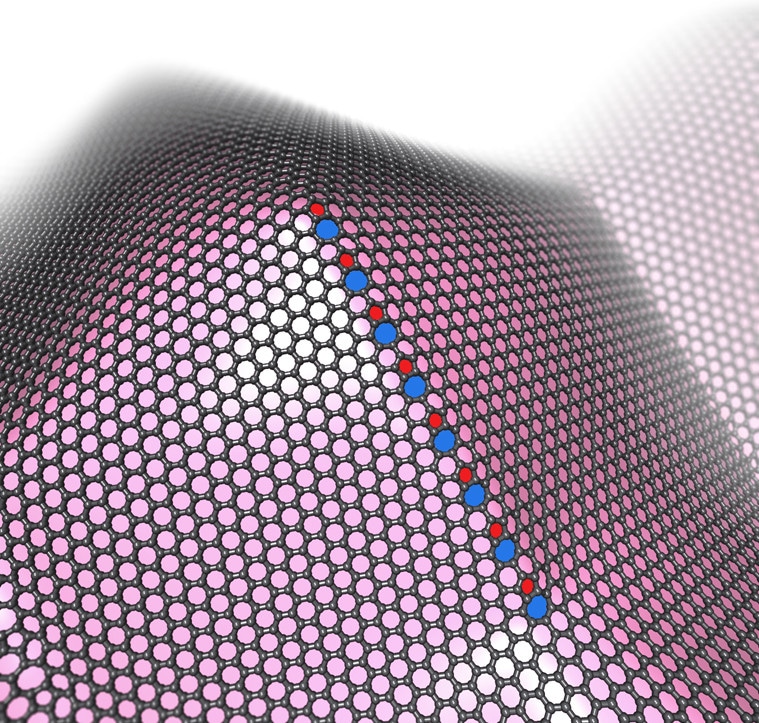Oct 20 2017
According to Penn State Materials Researchers, desirable properties such as enhanced mechanical properties, increased electrical conductivity, information processing or magnetism for memory storage may be possible because of a theoretical technique to manipulate grain boundaries in two-dimensional (2D) materials.
 A grain boundary forms when graphene growth advances past an apex on a conical bump, where the curvature resembles that on a sphere; it terminates at the foot of the bump, where curvature is saddle-like. (Image: Crespi Lab / Penn State)
A grain boundary forms when graphene growth advances past an apex on a conical bump, where the curvature resembles that on a sphere; it terminates at the foot of the bump, where curvature is saddle-like. (Image: Crespi Lab / Penn State)
Intense study has been carried out on 2D materials over the last 10 years, but before the work of Yuanxi Wang, a recent Penn State Doctoral Graduate and Vincent H. Crespi, renowned Professor of Physics, Materials Science and Engineering and Chemistry at Penn State, no one had devised a universal way to manipulate the location and type of grain boundaries in 2D materials.
When you are growing a 2D material, a thin film, you are depositing materials on a substrate. As the atoms fall onto the substrate, they self-organize into crystalline areas called grains.
Vincent H. Crespi, renowned Professor of Physics, Materials Science and Engineering and Chemistry, Penn State
When the grains expand, they bump into other growing crystalline regions, and where they meet is termed as the grain boundary. But like tiling a floor by tossing the tiles casually, the orientation of the grains and grain boundaries are random, which impacts the material properties.
Until this research, published in the Nano Letters journal, these random grain boundaries were mostly considered to be unfortunate derivatives of the deposition process.
Typically, when you are growing a material, those random grain boundaries are bad. The atoms don't mate to each other the way they do in ordinary crystals. Current and heat don't pass through easily. They tend to scatter heat and electrons.
Vincent H. Crespi, renowned Professor of Physics, Materials Science and Engineering and Chemistry, Penn State
Crespi and Wang had the idea that by controlling the underlying substrate, they could predetermine where the grain boundaries would start and end, and make them line up in systematic positions. The main shapes were based on something known as Gaussian curvature, a series of hemispherical bumps and dips on a substrate that looks like an egg carton.
Wang did calculations that revealed that for two extensively examined 2D materials, molybdenum disulfide and graphene, the growth would create grain boundaries in specific locations instead of detaching from the substrate or developing undesirable folds. If the 2D material does not stick well to the substrate, it will create a fold.
"We found that the energetics and kinetics of forming grain boundaries versus a fold or detachment, were favorable in graphene and molybdenum disulfide, and applicable to any 2D material," Wang said. "But not any bump would do. They have to have Gaussian curvature."
Applications include memory storage, where manipulating the magnetic state of a 2D magnetic-grain boundary system by applying a voltage would be an extremely useful capability. The fine control of electronic properties via grain boundaries might also be applied in spintronics, which is processing information using the spin of electrons. These grain boundaries also frequently control the mechanical properties of materials, such as how they react under stretching.
This gives people a new way of thinking about optimizing the properties of 2D materials where they have more control than previously. We didn't know we could have such fine control of grain boundaries, and so we didn't think about carefully studying the magnetic, thermal and electronic properties of grain boundaries with an eye toward creating 'grain boundary materials' whose properties are determined by a controlled distribution of specified grain boundaries.
Vincent H. Crespi, renowned Professor of Physics, Materials Science and Engineering and Chemistry, Penn State
Their research paper in Nano Letters is titled "Theory of Finite-Length Grain Boundaries of Controlled Misfit Angle in Two-Dimensional Materials.
The National Science Foundation Materials Innovation Platform and a U.S. Army Research Office MURI grant supported this research. Wang is currently a research associate in the NSF-funded Two-Dimensional Crystal Consortium- Materials Innovation Platform at Penn State.